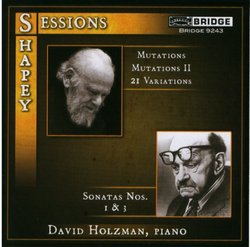| All Artists: David Holzman Title: Sessions and Shapey: Piano Music Members Wishing: 0 Total Copies: 0 Label: Bridge Original Release Date: 1/1/2007 Re-Release Date: 12/5/2007 Genres: New Age, Classical Styles: Instrumental, Chamber Music, Forms & Genres, Sonatas, Historical Periods, Classical (c.1770-1830), Modern, 20th, & 21st Century Number of Discs: 1 SwapaCD Credits: 1 UPC: 090404924323 |
Search - David Holzman :: Sessions and Shapey: Piano Music
 | David Holzman Sessions and Shapey: Piano Music Genres: New Age, Classical
|
Larger Image |
CD Details |
CD ReviewsModernity at variegated poles scarecrow | Chicago, Illinois United States | 03/12/2008 (5 out of 5 stars) "it is pointless to hear the two 'Mutations' here consecutively, although 'Mutations I' is a first affirmation of a young creator with some vision. The work dates from 1956,premiered then in New York City; Shapey was drawn quite early to the paradigm of modernity; in the pitch-modules and timbral spatiality of Varese,(whom he had known closely) as well as the implications within pitch constructions developed by Stefan Wolpe, who he studied with for a brief time.
Shapey,unpretenciously saw how to improve on both composers seeing inside the implications of their work.Theoretically as well he spent his long life doing it. "Mutations II" is a mature durable work, a seminal statement,although it has taken some time for me to warm-up to it, preferring the early young violence of the "Mutations I". Both share however a typical rugged power; roaring lower registers irrational-like gestures, crunching half step tones in the middle register overwhelming basso exploited,placed within discreet shapes,contraction and expansion working together and in opposition. The work's titles suggest a "virus", cells/shapes gone awry;but always with a sense of ongoing rational motions,nothing(no gestures or ideas) gets trapped as we find in the latter piano solo music; the piece proceeds with an iterative, re-iterative idea a shape,a cell, a module, that attests to simultaneously a stability of gesture and a neurotic forward motion; to proceed, for that's what music does, proceeds within a continuum a discourse in time. "Mutations II" was simply a development,ten years later; time now to contemplate existence; the luxury of space,seeing history pass by always gives content;we find here more full bodied arresting pointillistic passages, but all related to the brevity of the intervallic content chosen by Shapey.Structure is always within compact classical shapes, and he frequented thought of his music as an "object", a shape, a constructive form with geometrical elements. He sought meaning his entire existence in smaller more seeable musical forms as "variations","chamber concerti",odd assortments of "duets", and "trios", as well as ten "string quartets" that traversed his life with him;Developing genres itself through this constructive means was part of his philosophy. Not leaving "Mutations I" in the shadow of its successor, however has powerful moments as well with the early budding dotted unit followed by a sixteenth or thirty second gesture,and mysteries with on-going quarter and eighth values; an indelible signature of his rhythmic constituion, as well as encapsulating musical ideas shaped in tuplets/triplets. You find this more with the "21 Variations", a sprawling screens of shapes,forms,configurations, that nicely situates really all Shapey has to say to the world in this one single piece. It moves from defiant, stentorian gestures of pure rugged power, uncompromising, to mysteriously gentle solitudes, music at an end point reduced to simple pure intervallic high register timbres,always with a middle and basso counterpoint to help shape the space. Shapey formed his music within a spatiality of means, a dimension he engages with antiphonal shapes within his chamber oeuvre, more than piano solo, but here the clarity is overwhelming something Mr.Holzman comprehends very well within the frames of this music. There are questions also in the "21 variations" allowing one to contemplate the indelible violences that have occurred within the work within humanity itself. Although Shapey never openly spoke in political social discourse, the anxiety ridden content of his music speaks for itself; with an affirmation a committment to the creativity to find meaning through timbre and its construction. It was nice hearing the early 1930 'First Sonata' of Roger Sessions,a neglected composer in some respects; very lyrical rotund rimantic shapes herein, very agreeable music here like the sociality suggested in the painterly images of Ben Shahn, or Peter Blume. The "Third Sonata" (1963-65) dedicated to JFK points to another time it is much more mature chromatic, turgid, edge/anxiety music of remorse, I suppose Sessions dedication here still rings within an unknown resonance,perhaps the most powerful aspect of the work; for there remains unanswered questions. Sessions never really located a musical aesthetic consistent with a workable language,simply to say "chromatic" or quasi-atonal explains little; his creativity then never really "toke-off", to give it an independent paradigm for which he could create interesting works. He never really seemed to be committed to musical innovation,shunned the developments in Europe, and could not read how to utilize effectively the innovations transmogrified,and re-interpreted from the American experience either. His music however is deeply thought through well-crafted but without that outer dimension that compells and solicits the imagination, that engages the listener to also visit other "Other" places. Lyricism, within the dimensions of the human voice, seems to be his lifelong language,one that he knows what to do with, within predictable traditional forms." |

 Track Listings (11) - Disc #1
Track Listings (11) - Disc #1